Zachary Taylor Worksheets
Do you want to save dozens of hours in time? Get your evenings and weekends back? Be able to teach about Zachary Taylor to your students?
Our worksheet bundle includes a fact file and printable worksheets and student activities. Perfect for both the classroom and homeschooling!
Resource Examples
Click any of the example images below to view a larger version.
Fact File
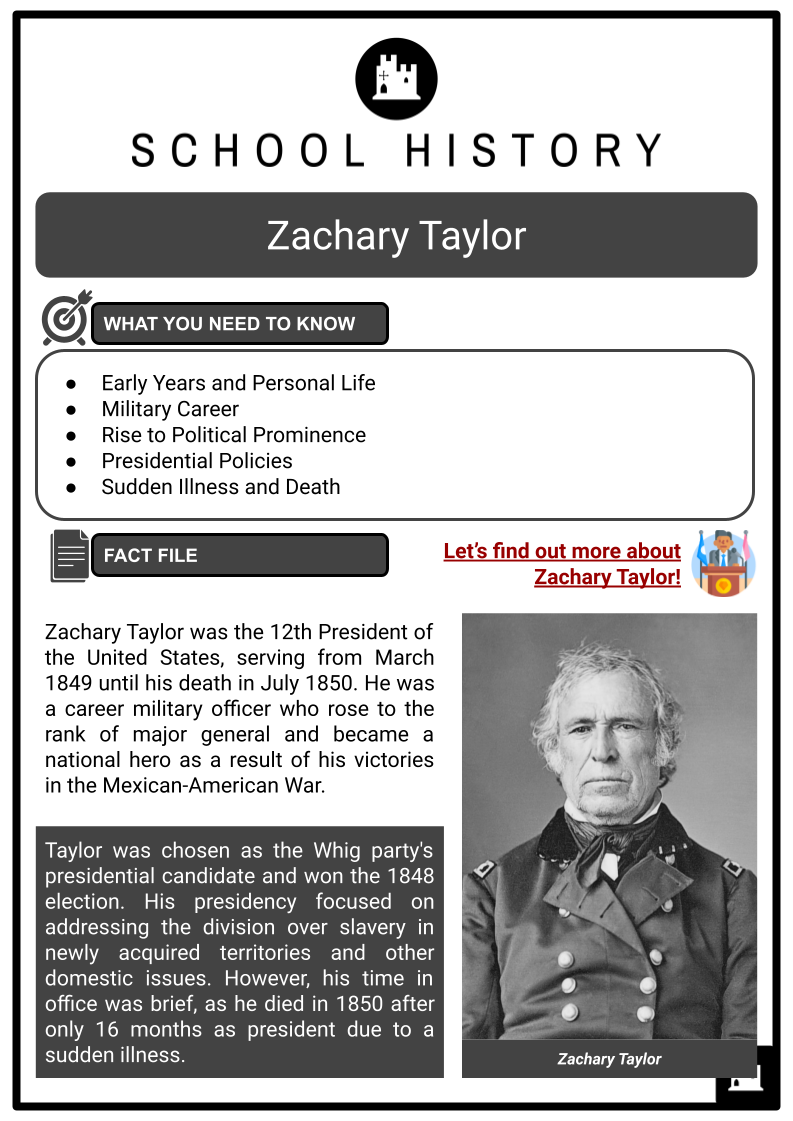
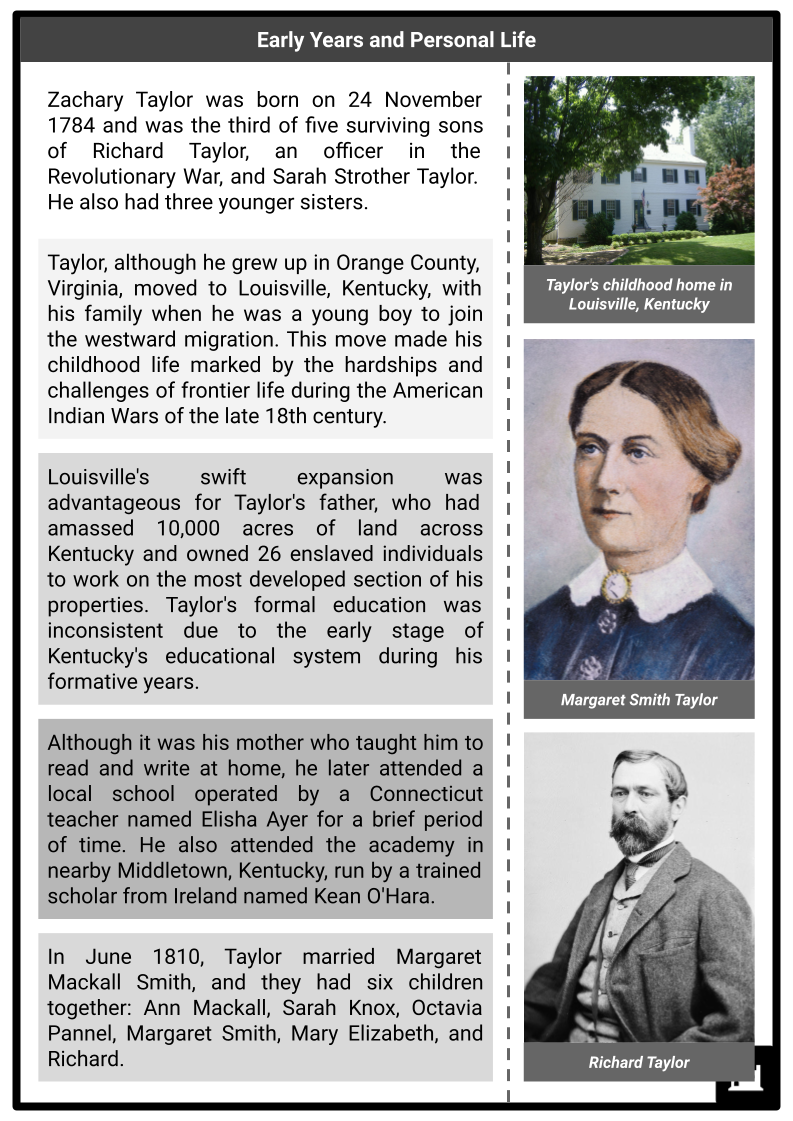
Student Activities
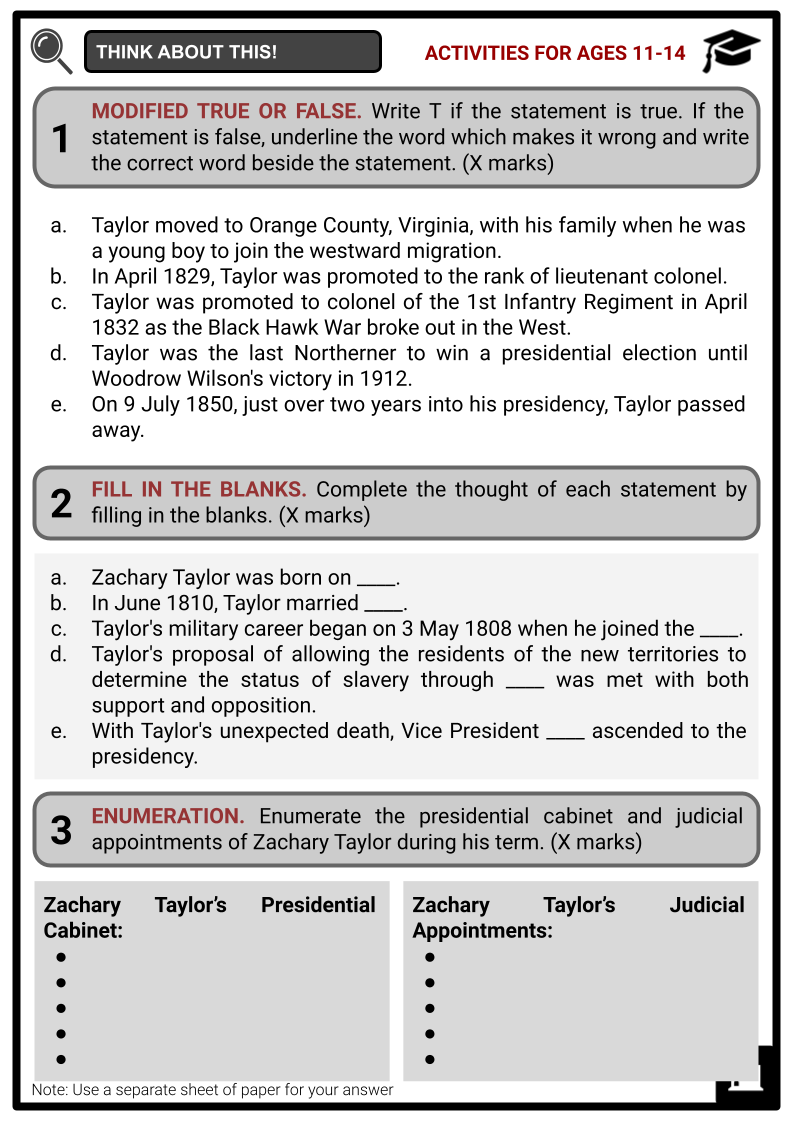
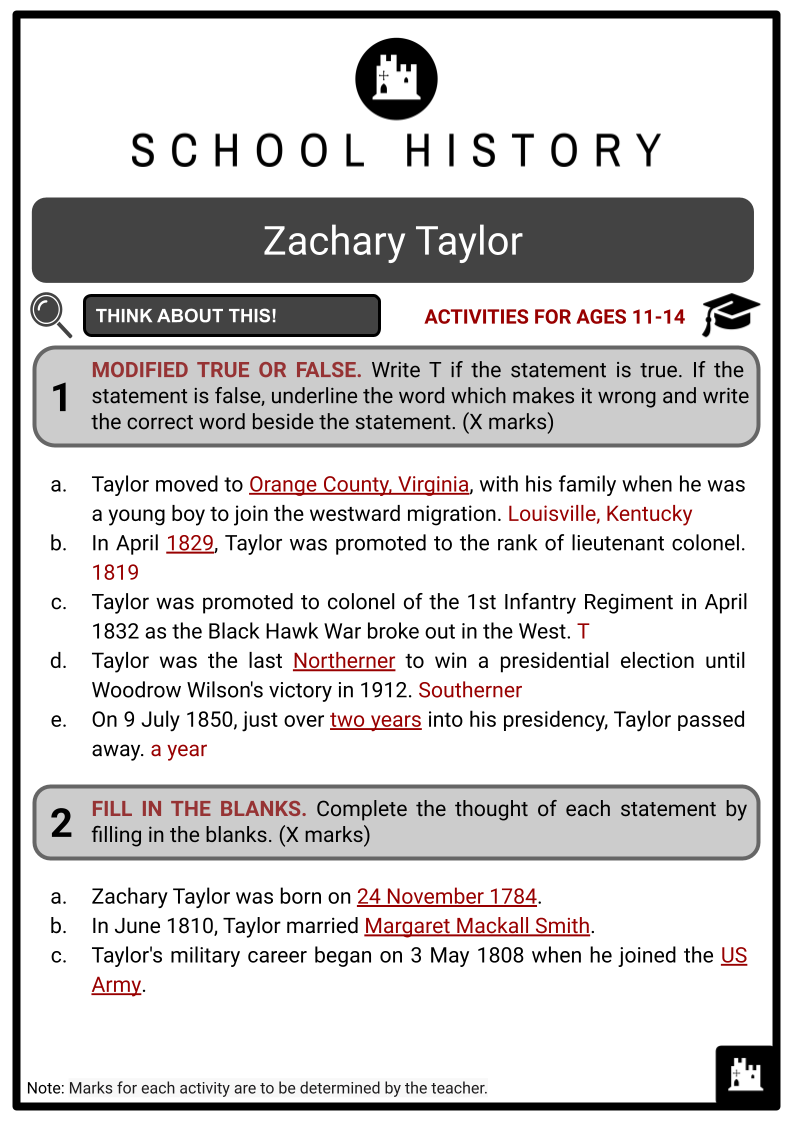
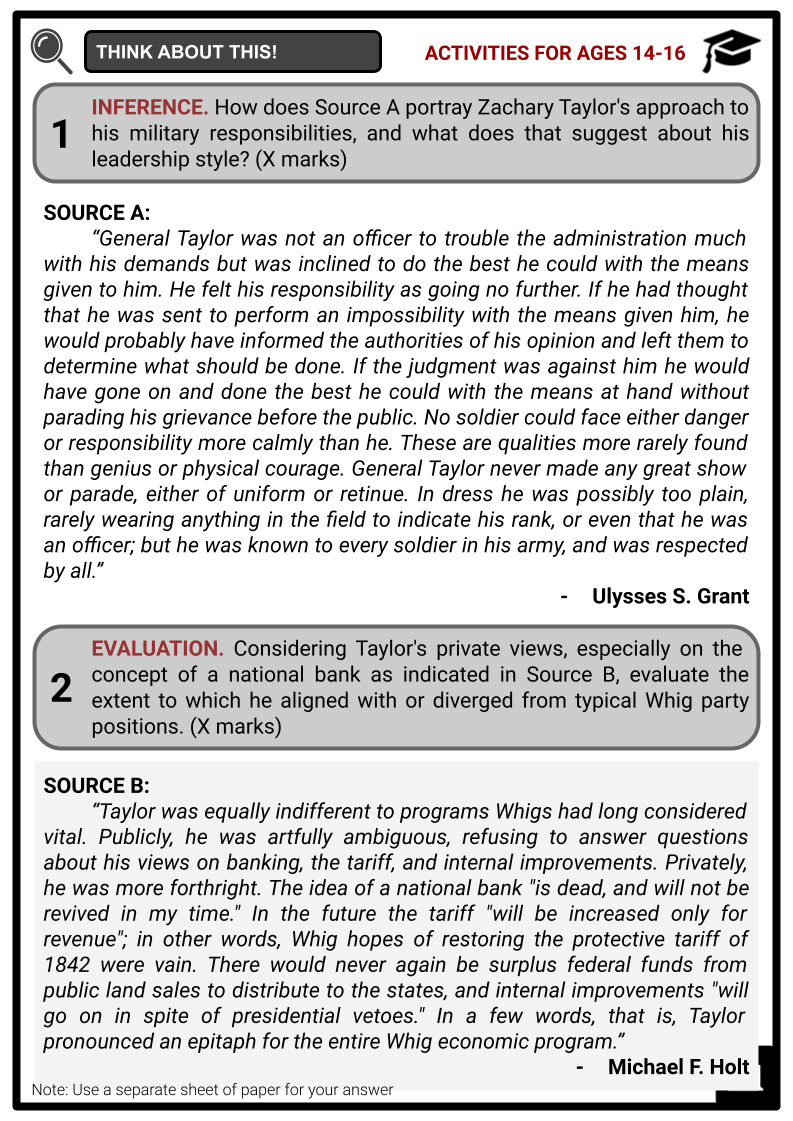
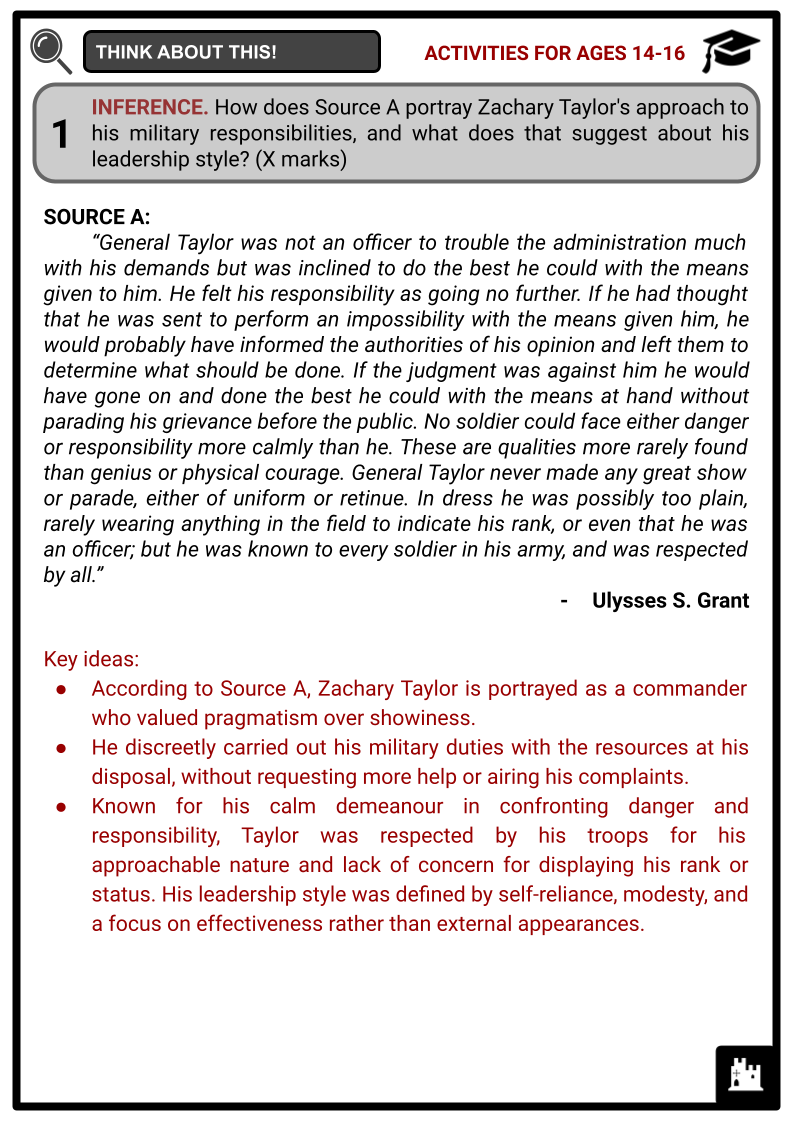
Summary
- Early Years and Personal Life
- Military Career
- Rise to Political Prominence
- Presidential Policies
- Sudden Illness and Death
Key Facts And Information
Let’s find out more about Zachary Taylor!
Zachary Taylor was the 12th President of the United States, serving from March 1849 until his death in July 1850. He was a career military officer who rose to the rank of major general and became a national hero as a result of his victories in the Mexican-American War. Taylor was chosen as the Whig party's presidential candidate and won the 1848 election. His presidency focused on addressing the division over slavery in newly acquired territories and other domestic issues. However, his time in office was brief, as he died in 1850 after only 16 months as president due to a sudden illness.
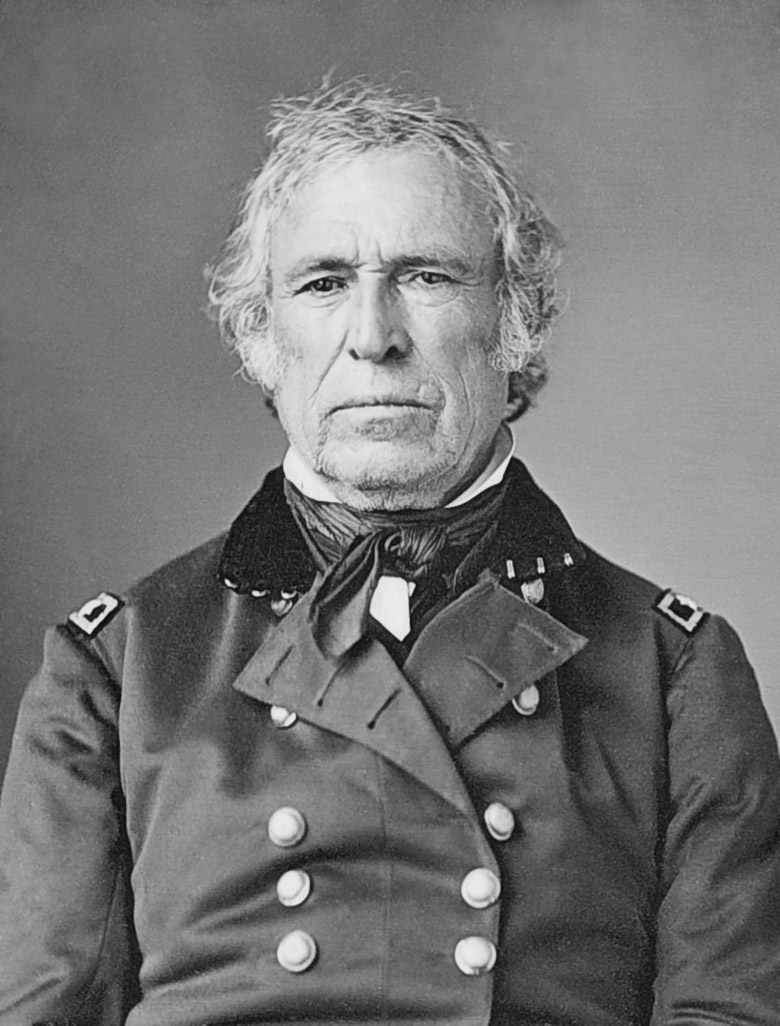
Early Years and Personal Life
- Zachary Taylor was born on 24 November 1784 and was the third of five surviving sons of Richard Taylor, an officer in the Revolutionary War, and Sarah Strother Taylor. He also had three younger sisters.
- Taylor, although he grew up in Orange County, Virginia, moved to Louisville, Kentucky, with his family when he was a young boy to join the westward migration. This move made his childhood life marked by the hardships and challenges of frontier life during the American Indian Wars of the late 18th century.
- Louisville's swift expansion was advantageous for Taylor's father, who had amassed 10,000 acres of land across Kentucky and owned 26 enslaved individuals to work on the most developed section of his properties. Taylor's formal education was inconsistent due to the early stage of Kentucky's educational system during his formative years.
- Although it was his mother who taught him to read and write at home, he later attended a local school operated by a Connecticut teacher named Elisha Ayer for a brief period of time. He also attended the academy in nearby Middletown, Kentucky, run by a trained scholar from Ireland named Kean O'Hara.
- In June 1810, Taylor married Margaret Mackall Smith, and they had six children together: Ann Mackall, Sarah Knox, Octavia Pannel, Margaret Smith, Mary Elizabeth, and Richard.
Military Career
- Taylor's military career began on 3 May 1808 when he joined the US Army. He received a commission as a first lieutenant in the Seventh Infantry Regiment and was stationed near New Orleans.
- In November 1810, Taylor was promoted to the rank of captain. Because of his limited army duties, he was able to focus on his personal life and agricultural pursuits. He was able to purchase a plantation in Louisville and in Jefferson County, Mississippi Territory. The acquisitions comprised enslaved individuals, whose numbers grew to exceed 200.
- In July 1811, Taylor was summoned to the Indiana Territory and took charge of Fort Knox after the commanding officer fled. Within a short period, he successfully brought back stability to the fort, earning praise from Governor William Henry Harrison.
- During the War of 1812, Taylor demonstrated strong leadership and military expertise when he defended Fort Harrison in Indiana Territory against a Native American attack led by Tecumseh. This battle marked the first land victory for US forces during the war and earned Taylor widespread acclaim, along with a temporary promotion to major.
- Later in the same year, Taylor served as an assistant to General Samuel Hopkins on two missions: one into the Illinois Territory and another to the Tippecanoe battle location. They were compelled to withdraw during the Battle of Wild Cat Creek.
- In 1814, Taylor was called back into action under Brigadier General Benjamin Howard. When Howard became ill, Taylor commanded a 430-man expedition from St. Louis, sailing up the Mississippi River. He achieved victory over Native American forces in the Battle of Credit Island but withdrew when the Native Americans were reinforced by their British allies.
- When the war concluded in 1815, he stepped down as a captain and left the military. He rejoined the army after obtaining a commission as a major one year later.
- In April 1819, Taylor was promoted to the rank of lieutenant colonel and dined with President James Monroe and General Andrew Jackson.
- In late 1820, he took the 7th Infantry to Natchitoches, Louisiana, on the Red River but was transferred to Baton Rouge on the Mississippi River in Louisiana two years later. He remained there until February 1824. He spent the next few years on recruiting duty.
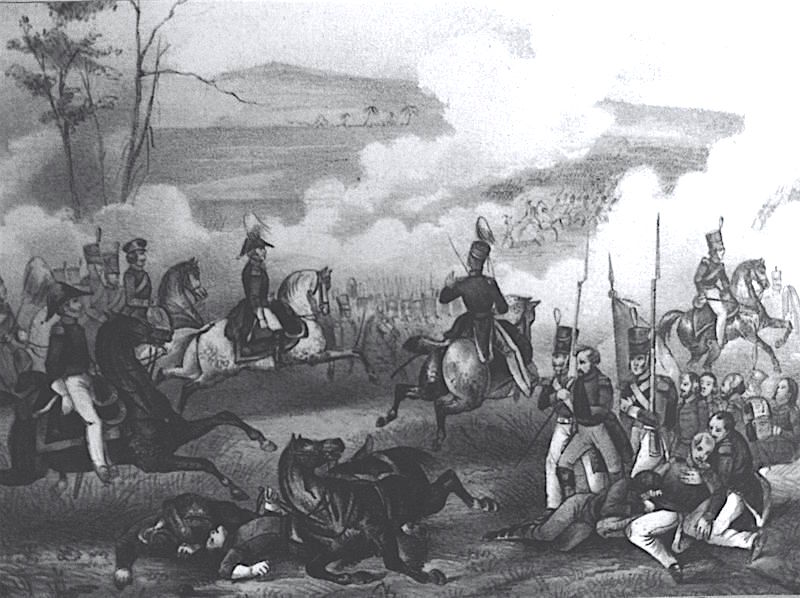
- In May 1828, Taylor was summoned back to duty, taking charge of Fort Snelling in Michigan Territory (now Minnesota) along the Upper Mississippi River for a year. He then moved on to nearby Fort Crawford for another year.
- After some time on leave, he was promoted to colonel of the 1st Infantry Regiment in April 1832 as the Black Hawk War broke out in the West. Campaigning under General Henry Atkinson, Taylor pursued and later defended against Chief Black Hawk's forces throughout the summer. The conclusion of the war in August 1832 marked the end of Indian resistance to US expansion in that region.
- By 1837, the Second Seminole War had commenced when Taylor was assigned to Florida.
- He participated in a confrontation with the Seminole Native Americans during the Battle of Lake Okeechobee, which stood as one of the largest conflicts between US forces and Native Americans in that century. This led to his promotion to brigadier general.
- In May 1838, Major General Thomas Jesup stepped down and entrusted Taylor with command over all American troops in Florida for two years. During this time, he gained recognition as a formidable military leader and became known as "Old Rough and Ready."
- Following his requested break from duty, Taylor enjoyed a leisurely year travelling across the country with his family while engaging with military figures. It was during this period that he developed an interest in politics and corresponded with President William Henry Harrison. In May 1841, he assumed command of the Army's Western Division within its Second Department.
- In anticipation of the annexation of the Republic of Texas, Taylor was sent to Fort Jesup in Louisiana in April 1844 and ordered to guard against Mexican attempts to reclaim the territory. Despite more senior generals being available for this command, Taylor's apolitical reputation and friendly relations with Andrew Jackson made him President James K. Polk's choice over Whig Party members Winfield Scott and Edmund P. Gaines.
- Polk's negotiations with Mexico failed, leading to Taylor's advance to the Rio Grande in March 1846 and sparking an imminent war. Violent confrontations occurred as Mexican forces attacked Captain Seth B. Thornton's men north of the river. Despite being greatly outnumbered, Taylor commanded American victories at the Battle of Palo Alto and the nearby Battle of Resaca de la Palma against General Mariano Arista's "Army of the North." These triumphs elevated Taylor to a popular hero, prompting his promotion to major general by Congress in May 1846 and then to full rank in June.
- After crossing the Rio Grande, Taylor achieved victory at the Battle of Monterrey and later established a strong defensive position near Saltillo. Santa Anna attacked with 20,000 men at the Battle of Buena Vista in February 1847, leading to a significant American victory. Taylor was honoured for his victory at the battle on 4 July 1847. He received numerous accolades, including membership in prestigious societies and three Congressional Gold Medals, for his service in the Mexican-American War.
- Taylor's military career effectively ended in late November 1847, when he set sail for home. He received a hero's welcome in New Orleans and Baton Rouge the following month, setting the stage for the 1848 presidential election.
Rise to Political Prominence
- After his celebrated military career, Taylor's victories in the Mexican-American War turned him into a national hero and propelled him into the political arena. He attracted the attention and support of both the Whig and Democratic parties. His apolitical reputation, gained from his military service and unaffiliated stance, made him an appealing candidate for the presidency.
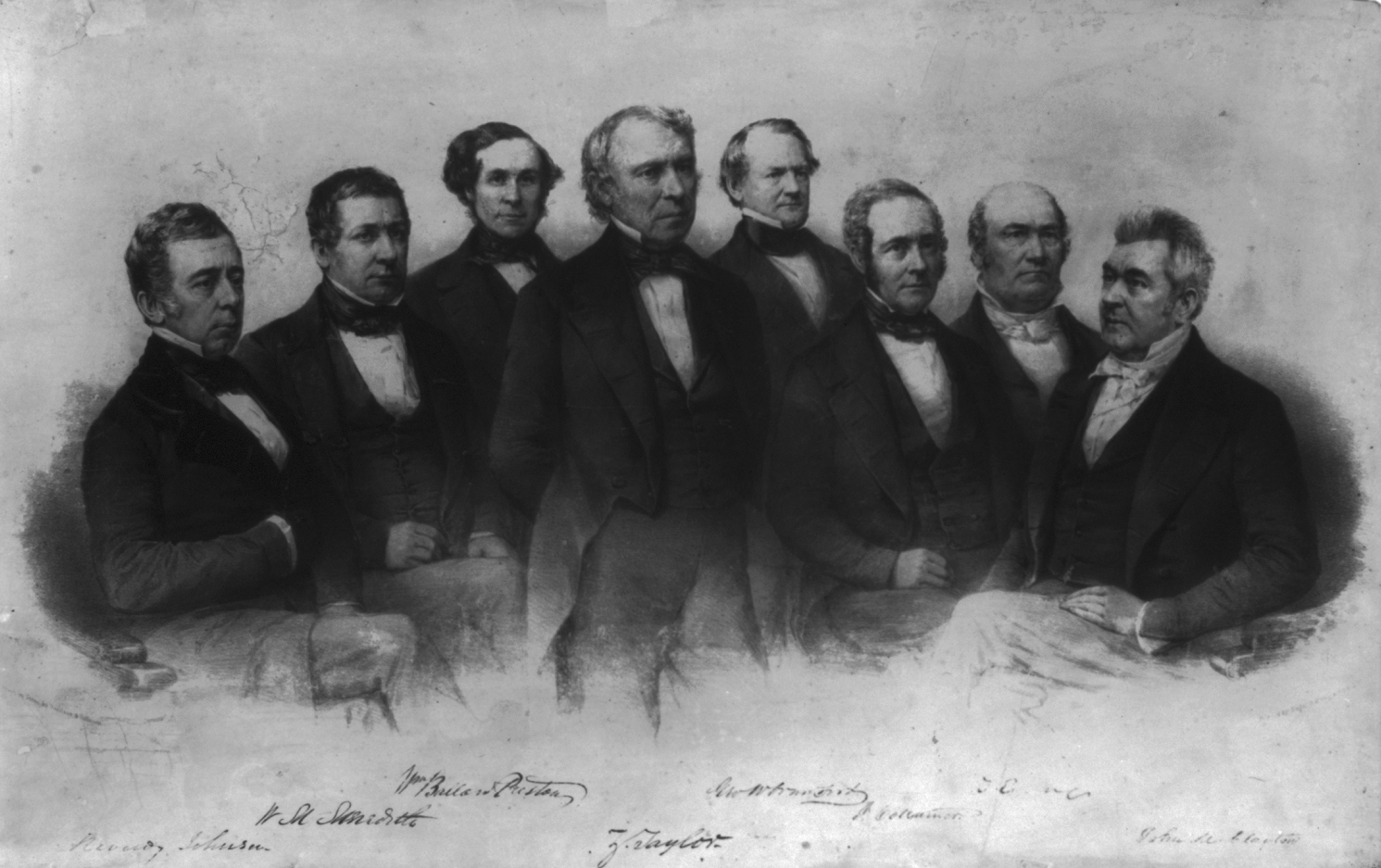
- In a September 1847 letter, Taylor expressed his views on various issues. He opposed chartering another national bank and favoured a low tariff. He believed the president should not make laws but could veto them if they were unconstitutional. Some Southerners thought Taylor supported slavery's expansion into new territories, and there was controversy over his stance on the Wilmot Proviso. Many abolitionists did not support him due to his ownership of enslaved individuals.
- In February 1848, Taylor hesitated to accept a presidential nomination from either party. Despite his reluctance to identify as a Whig, he was eventually convinced by supporters and secured the nomination at the 1848 Whig National Convention through skilful campaign direction and endorsements.
- Democrats were divided, with former President Martin Van Buren leading the anti-slavery Free Soil Party and winning support from both Democrats and Whigs who opposed slavery extension. Van Buren's candidature took more votes from Democratic nominee Lewis Cass in New York.
- Taylor won over Cass and Van Buren by securing 163 out of the 290 electoral votes. In terms of popular vote, he garnered 47.3%, compared to Cass's 42.5% and Van Buren's 10.1%.
- Taylor marked the end of Whig party presidents as well as being the final individual elected president without affiliation to either the Democratic or Republican parties. He was also the last Southerner to win a presidential election until Woodrow Wilson's victory in 1912.
- As the incoming president, Taylor postponed stepping down from his role in commanding the Western Division until the end of January 1849. During this time, he carefully selected members for his cabinet and kept his decision-making process low-key, which caused frustration among other Whigs. Despite his dislike for patronage and political manoeuvring, he received numerous requests from individuals seeking positions in his administration.
- Zachary Taylor's Cabinet Members:
- John M. Clayton as Secretary of State
- William M. Meredith as Secretary of the Treasury
- George W. Crawford as Secretary of War
- Reverdy Johnson as Attorney General
- Jacob Collamer as Postmaster General
- Thomas Ewing as the first Secretary of the Interior (a new department created during Taylor's presidency)
- William B. Preston as Secretary of the Navy
- Zachary Taylor's Judicial Appointments:
- John Gayle
- Henry Boyce
- Daniel Ringo
- Thomas Drummond
- On 5 March 1849, Zachary Taylor stood before a crowd gathered in front of the United States Capitol to take the oath of office and be inaugurated as the 12th President of the United States. The inauguration ceremony was a grand affair, with dignitaries, military personnel, and citizens from all corners of the country in attendance.
- In his inaugural address, Taylor emphasised the importance of preserving the Union and maintaining peace. He spoke of his commitment to upholding the Constitution and the laws of the land, and he expressed his desire to promote the well-being and prosperity of all citizens, regardless of their political beliefs or affiliations.
Presidential Policies
- As Taylor assumed the presidency, he faced a nation deeply divided over the issue of slavery and the expansion of territories. His policies aimed to address these contentious matters and maintain unity within the country.
-
Slavery and Territorial Expansion
- Despite Taylor's ownership of enslaved individuals, his presidency was marked by significant debates and conflicts regarding slavery and territorial expansion. The acquisition of new territories from the Mexican-American War raised the issue of whether these regions would permit the institution of slavery. This issue worsened the already deep divisions between the pro-slavery and anti-slavery factions in the country.
- Taylor's proposal to allow the residents of the new territories to determine the status of slavery through popular sovereignty was met with both support and opposition. Proponents of popular sovereignty believed it offered a democratic solution to the issue, allowing the people in those territories to decide for themselves. However, critics argued that this approach was a way to shift the responsibility of making a definitive decision on the issue of slavery onto the local populations, potentially ignoring and violating the rights of enslaved individuals.
- The debates over the expansion of slavery and the applicability of popular sovereignty deeply divided the nation, with tensions escalating and further threatening the stability of the Union.
-
Native American Relations
- Despite Taylor's ownership of enslaved individuals, his presidency was marked by significant debates and conflicts regarding slavery and territorial expansion. The acquisition of new territories from the Mexican-American War raised the issue of whether these regions would permit the institution of slavery. This issue worsened the already deep divisions between the pro-slavery and anti-slavery factions in the country.
-
Economic Policies
- Taylor's policies on economic matters were centred around a low tariff and cautious fiscal management. He believed in minimising government intervention in the economy and advocated for the limited role of the federal government in regulating trade and industry. His preference for a low tariff was aimed at maintaining economic stability and fostering trade relationships both domestically and internationally.
-
Foreign Policy
- In the realm of foreign affairs, Taylor pursued a policy of maintaining a stance of neutrality and non-intervention in the affairs of other nations. While his presidency was primarily focused on domestic matters, Taylor upheld diplomatic relations with foreign powers and emphasised peaceful resolutions to international conflicts.
Sudden Illness and Death
- Taylor's presidency was cut short by a sudden illness that would ultimately lead to his untimely death. In 1850, Taylor attended various Fourth of July celebrations in Washington, D.C.
- He reportedly consumed a variety of raw fruits and iced milk, despite the sweltering heat, which took a toll on his health.
- Shortly thereafter, Taylor fell ill with severe stomach cramps and a high fever. His condition rapidly deteriorated, and medical professionals diagnosed him with cholera morbus, a term used at the time to describe severe gastroenteritis.
- Despite receiving medical treatment, including remedies such as doses of ipecac and opium, his health continued to decline.
- As days passed, his condition worsened, and on 9 July 1850, just over a year into his presidency, he passed away.
- With Taylor's unexpected death, Vice President Millard Fillmore ascended to the presidency. Taylor's sudden illness and death have led to speculation, conspiracy theories, and lingering questions about the exact cause of his demise.
- The unresolved issues surrounding his death continue to intrigue historians and scholars due to Taylor's presidency legacy.
Image Sources
- https://upload.wikimedia.org/wikipedia/commons/5/51/Zachary_Taylor_restored_and_cropped.jpg
- https://upload.wikimedia.org/wikipedia/commons/7/75/General_Zachary_Taylor_rides_his_horse_at_Palo_Alto_Battle_-_May_8%2C_1846.JPG
- https://upload.wikimedia.org/wikipedia/commons/b/b2/President_Taylor_and_his_cabinet.jpg
Frequently Asked Questions
- Who was Zachary Taylor?
Zachary Taylor was the 12th President of the US, from March 1849 until his death in July 1850.
- What was Zachary Taylor's background before becoming president?
Before becoming president, Zachary Taylor was a career military officer. He rose through the ranks during the War of 1812 and the Black Hawk War and gained fame as a commander during the Mexican-American War.
- What was Zachary Taylor's background before becoming president?
Before becoming president, Zachary Taylor was a career military officer. He rose through the ranks during the War of 1812 and the Black Hawk War and gained fame as a commander during the Mexican-American War.
